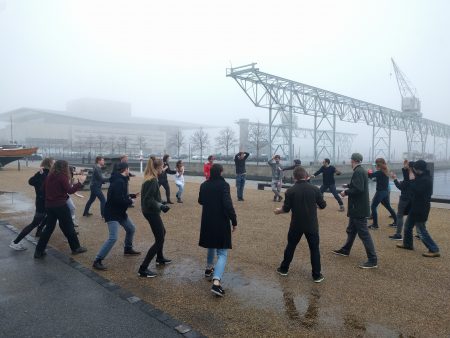This is for the program I run in Copenhagen. Join us!
 Apply to the Visual Game and Media Design Master’s program at KADK in Copenhagen. The Application deadline for the 2019-2021 class is March 1st.
Apply to the Visual Game and Media Design Master’s program at KADK in Copenhagen. The Application deadline for the 2019-2021 class is March 1st.
The application process is now open for the two-year Visual Game And Media Design master’s program at KADK – the Royal Danish Academy of Fine Arts, School of Design in Copenhagen.
Visual Game and Media Design is an intensive two-year program for students wishing to do creative work in game design, visual media, and beyond. During the program, you will continually combine the hands-on creation of digital games, animations, motion graphics and visual designs with innovative conceptual approaches to game design and storyworld design.
Who can apply?
The master’s program in Visual Game and Media Design is in English, and is open to all students, Danish and International, with a relevant bachelor’s degree in fields such as graphic design, game design, animation, or 3D modeling. We encourage students with nontraditional backgrounds to apply.
More about the program and application process
To learn more about the program, and to apply, go to the website or email program head Jesper Juul, jjuul@kadk.dk
https://kadk.dk/en/programme/visual-game-and-media-design
We have frequent lectures by industry luminaries. We have recently had talks by designers such as Richard Lemarchand, Mary Flanagan, Nathalie Pozzi, Eric Zimmerman, Robert Yang, Henrike Lode, Alfred Nguyen (Forgotten Anne), Trine Laier (Cosmic Top Secret), Mikkel Pedersen (Deep Rock Galactic), and Petter Henriksen (Landfall Games).
We also organize game jams in collaboration with the local industry, including the 2019 Nordic Game Jam.
Why study at KADK in Copenhagen?
KADK is a leading academy in Scandinavia in the fields of architecture, design and conservation. It is located centrally by the Copenhagen harbor.
Copenhagen is a hub for video game development, with a vibrant English-language game development community, and home to both small and large companies such as Sybo games, IO Interactive, Playdead and Unity3D.
KADK works closely with (and is situated next to) the National Film School of Denmark, and with the professional TV and Film community in Denmark.


